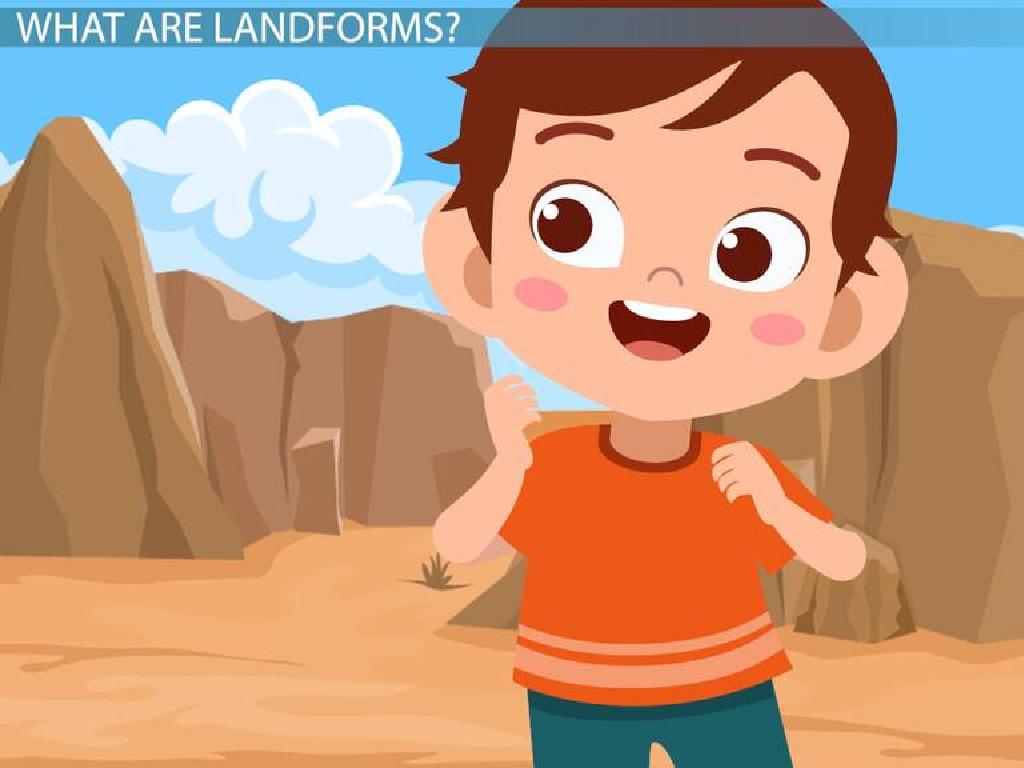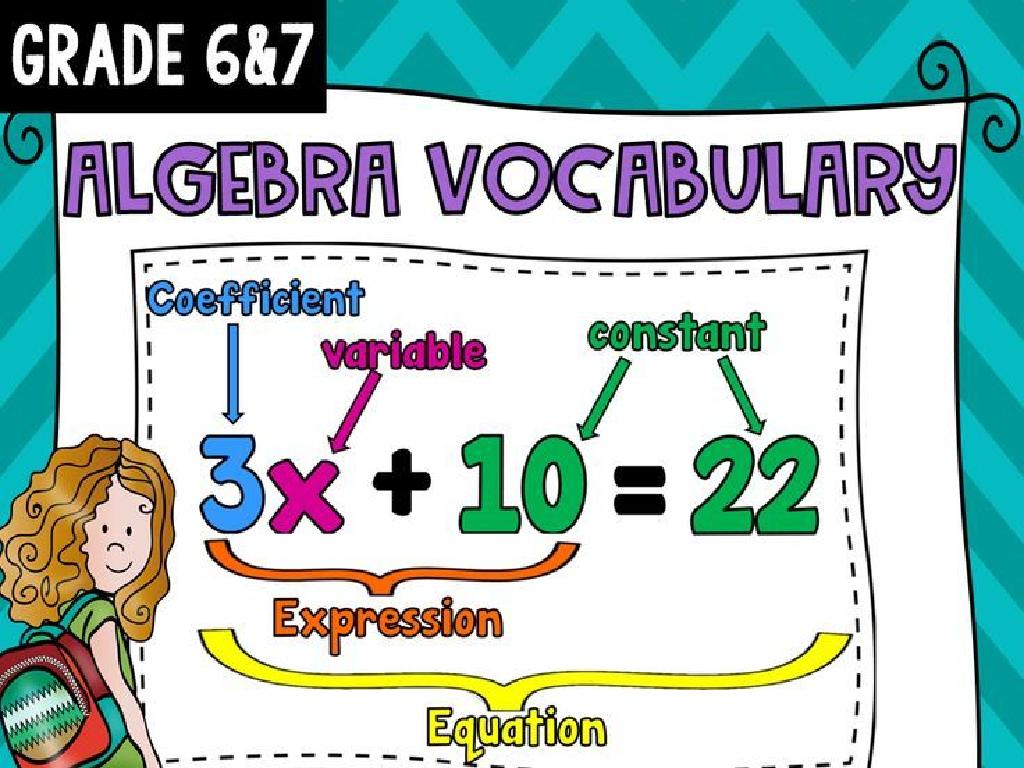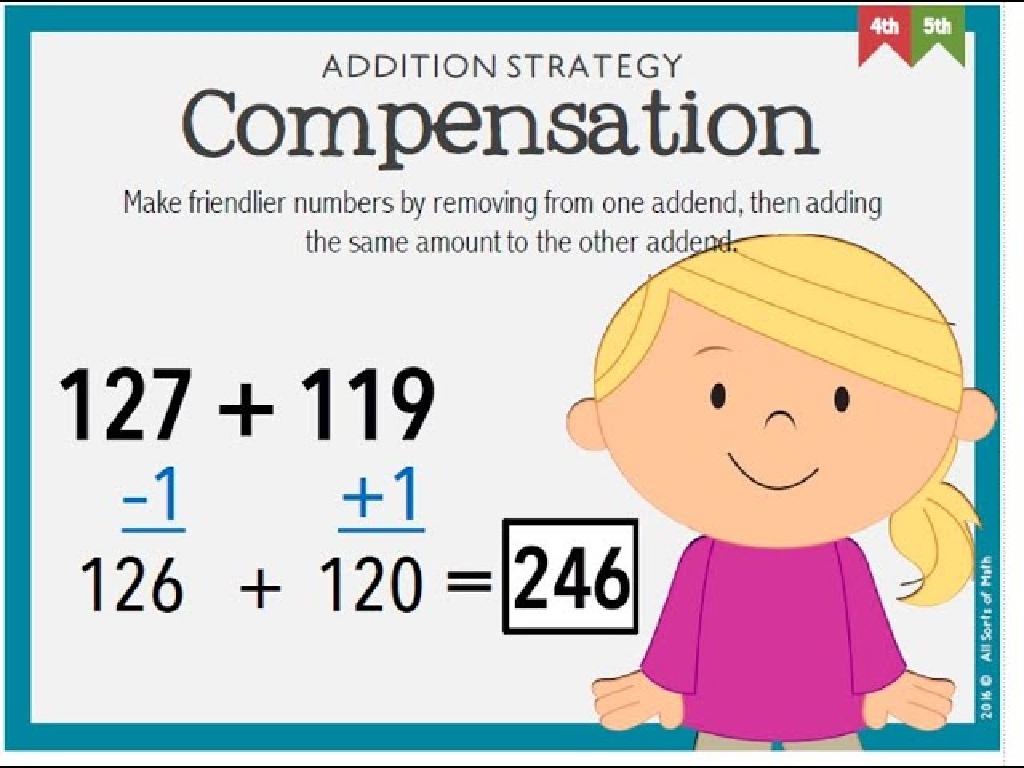Estimate Sums And Differences By Rounding: Up To 1,000
Subject: Math
Grade: Third grade
Topic: Estimate Sums And Differences
Please LOG IN to download the presentation. Access is available to registered users only.
View More Content
Welcome to Estimation!
– Learn to estimate sums & differences
– Rounding numbers to the nearest 10 or 100 to simplify
– Making good guesses with numbers
– Like detective work, using clues to approximate
– Estimation’s role in daily life
– Useful for quick calculations, like shopping or budgeting
– Practice estimation with examples
– We’ll round numbers and then add or subtract them
|
This slide introduces the concept of estimation, which is a fundamental skill in mathematics and daily life. Start by explaining that estimation is like making an educated guess about numbers. Emphasize the importance of being able to make quick and reasonable approximations, especially when exact numbers are not necessary. Provide examples such as estimating the total cost while shopping or planning a budget. Engage the students with simple rounding exercises, demonstrating how to round to the nearest ten or hundred before adding or subtracting. Encourage them to think of situations where they might use estimation outside of school.
Understanding Estimation
– Estimation is smart guessing
– Estimation is like guessing the number of candies in a jar
– It gives quick, close answers
– If something costs $19, we think $20 to make adding easier
– Rounding helps us estimate
– If you have 453 marbles, you round to 450 or 500 to estimate
– Practice makes estimation easy
|
This slide introduces the concept of estimation, which is a fundamental skill in mathematics, especially useful when exact answers are not required. Estimation allows students to make quick and reasonable guesses about a number. It’s important to emphasize that estimation is not about finding the exact answer, but rather a close approximation that is easy to compute. Rounding numbers to the nearest ten, hundred, or thousand is a common strategy to simplify calculations. Encourage students to practice rounding different numbers to get comfortable with the concept. Provide examples and possibly a quick in-class activity where students can round numbers and estimate sums or differences to reinforce the lesson.
Rounding Numbers Up to 1,000
– What does rounding mean?
– Making numbers simpler while staying close to original value.
– When do we round numbers?
– We round when we want an easier number to work with.
– Rounding to ten, hundred, or thousand
– We look at the digit right after the place we’re rounding to.
– Let’s practice rounding!
– We’ll do examples together to learn how to round!
|
This slide introduces the concept of rounding numbers as a way to simplify calculations while maintaining a number’s approximate value. Emphasize that rounding is useful in everyday situations, such as estimating costs or distances. Explain that the place to which we round (ten, hundred, or thousand) depends on the level of precision we need. Demonstrate rounding by looking at the digit to the right of the place value we’re rounding to: if it’s 5 or more, we round up; if it’s 4 or less, we round down. Engage the class with practice examples, rounding numbers to the nearest ten, hundred, and thousand. Encourage students to think of situations where they might need to round numbers in real life.
Rounding Numbers to Estimate Sums and Differences
– Identify the rounding digit
– The digit in the place you’re rounding to, e.g., tens, hundreds
– Examine the number to its right
– Is it 5 or more? Or is it 4 or less?
– Decide to round up or down
– 5 or more, round up; 4 or less, round down
– Turn digits right of it to zero
– For example, 843 becomes 840 when rounding to the nearest ten
|
This slide introduces the concept of rounding numbers as a foundational skill for estimating sums and differences. Start by explaining the importance of identifying the rounding digit, which is based on the place value students are asked to round to (tens, hundreds, etc.). Next, guide students to look at the number immediately to the right of the rounding digit to determine whether to round up or down. Emphasize that numbers 5 or higher mean rounding up, while 4 or lower mean rounding down. Finally, explain that all digits to the right of the rounding digit become zero to complete the rounding process. Use examples like rounding 843 to the nearest ten to illustrate the concept. Encourage students to practice with different numbers and place values to gain confidence in rounding.
Estimating Sums by Rounding
– Learn to round numbers first
– Round to the nearest ten or hundred to make adding easier.
– Add the rounded numbers
– Example: 256 + 433
– Round 256 to 260 and 433 to 430, then add to estimate the sum.
– Practice with more sums
– Try rounding and adding numbers on your own!
|
This slide introduces students to the concept of estimating sums by rounding numbers. Start by explaining the importance of rounding to the nearest ten or hundred to simplify addition. Show the example provided, rounding 256 to 260 and 433 to 430, and then adding them together to estimate the sum. Emphasize that this is an estimate, not the exact answer. Encourage students to practice this skill with additional problems, rounding numbers before adding to get an estimated sum. Provide several examples with varying degrees of difficulty and ensure to guide them through the process step by step.
Estimating Differences by Rounding
– Begin with rounding numbers
– Round to the nearest ten or hundred
– Subtract the rounded figures
– Use the new numbers to find an estimate
– Example: 789 – 347
– Round 789 to 790 and 347 to 350, then subtract
– Practice with similar problems
– Try estimating 465 – 289 by rounding first
|
When teaching third graders to estimate differences by rounding, start by explaining the concept of rounding to the nearest ten or hundred. This simplifies numbers and makes mental math easier. After rounding, guide them to subtract the rounded numbers to estimate the difference. Use the example provided to show how 789 rounds up to 790 and 347 rounds to 350, making the subtraction simpler and the result an estimate of the actual difference. Encourage students to practice with additional problems, rounding before subtracting to build their estimation skills. This technique helps them quickly approximate answers without needing exact calculations.
The Power of Estimation
– Estimation in shopping
– Round prices to guess total cost
– Estimation for planning trips
– Guess trip duration by rounding time
– Estimation checks math work
– Use rounding to verify answers
|
Estimation is a valuable skill that allows students to make quick and reasonably accurate calculations without needing the exact numbers. When shopping, students can round the prices of items to the nearest ten or hundred to get a rough idea of the total cost, which helps with budgeting. For planning trips, estimating the time it will take by rounding to the nearest hour can help in organizing the day. In math, estimation is a great way to check the plausibility of an answer; if the estimate is far off from the calculated answer, it might signal a mistake. Encourage students to practice estimation in real-life scenarios and to use it as a tool to double-check their work.
Let’s Practice Estimating!
– Practice problems on the board
– Round before adding or subtracting
– If a number is 345, we round to 350 before we add
– Work with a partner
– Choose a classmate to team up with for practice
– Estimate sums and differences
– Use rounding to find approximate answers
|
This slide is designed to engage students in a collaborative and interactive learning experience. Begin by solving a few estimation problems on the board as a class to demonstrate the process. Emphasize the importance of rounding numbers to the nearest ten or hundred before performing addition or subtraction. This will simplify the calculation and provide an estimated result. Pair up students and encourage them to work together to solve estimation problems. This activity will help them understand the concept of estimation and its practical application in everyday math. Provide guidance and support as needed, and ensure that each pair has a chance to share their answers with the class. Possible activities include estimating the total cost of items in a shopping list, the total number of items in a jar, or the difference in lengths of objects.
Class Activity: Estimation Station
– Set up estimation challenge stations
– Use rounding to estimate sums & differences
– Round numbers to the nearest ten or hundred to simplify
– Share estimates with the class
– Explain your estimation process
– Discuss how you decided to round each number
|
This interactive class activity is designed to help students practice their estimation skills by rounding numbers to the nearest ten or hundred. Set up various stations with different estimation challenges, each with a set of problems that require students to estimate sums and differences up to 1,000. Encourage students to use their rounding skills to simplify the numbers before estimating. After completing the challenges, students will share their estimates with the class and explain their thought process. This will help them articulate their understanding and learn from each other’s strategies. Possible activities include estimating the cost of groceries, the total distance traveled in a week, or the number of items in a jar. The goal is to reinforce the concept of rounding and its practical application in estimating larger numbers.
Estimation Mastery & Homework
– Congrats on learning estimation!
– Practice is key to perfection
– Complete the estimation worksheet
– Round numbers, then add or subtract
– Bring your worksheet to class
– Show your work for full credit
|
This slide wraps up the lesson on estimation by congratulating the students on their hard work and reminding them of the importance of practice. The homework assignment is to complete an estimation worksheet that focuses on rounding numbers to the nearest ten or hundred and then adding or subtracting to estimate sums and differences. This will help reinforce the day’s lesson and prepare them for more complex problems. Encourage students to show all their work on the worksheet to receive full credit. Remind them to bring the completed worksheet to the next class for review and discussion.






